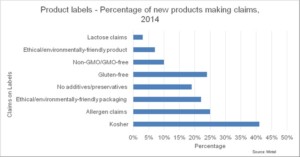Kosher food seems to be everywhere these days. Whether you are watching a Hebrew National hotdog commercial on TV or eating out at one of the many kosher restaurants in LA, you can’t help but notice the proud labeling displayed on the many kosher food options available. Growing up in a kosher home, I was always told to check for the kosher label on a food product before placing it into the grocery cart. But what exactly is kosher?
Kosher labeled foods comply with regulations prescribed by Jewish religious dietary laws. The three most basic provisions of kosher law are as follows:
- Derived from an allowable source: certain meats such as pork and shellfish are inherently disqualified
- Slaughter: There are strict instructions detailing the proper methods to slaughter livestock
- Preparation: Combining meat and dairy ingredients (or eating them within a specific amount of time from each other) is forbidden
Many American food companies are incurring additional overhead costs to certify and label an estimated 40 percent of food products as kosher certified. Given that Jews approximate 2 percent of the total United States’ population and about 25 percent of them (roughly 1.5 million people) adhere to some form of kosher observance, I began to wonder why. According to the Orthodox Union, the world’s largest kosher certification agency, there are approximately 200,000 kosher certified products available in the United States today. Approximately 12 million American consumers seek out these products, allowing the kosher food industry to generate an estimated $13 billion dollars in annual revenue.
Although the majority of kosher sales are attributed to strictly kosher Jewish households, many kosher food consumers are not Jewish. Kosher food is sought after for a variety of reasons including health, veganism, vegetarianism, allergies and other religious restrictions such as the Islamic law of Halal.
It is important to note, however, that the majority of consumers purchase kosher foods due to the widespread belief that they are healthier and of higher quality than their non-kosher versions. This stems from a distrust of the Food and Drug Administration (FDA) and some of its looser regulations involving additives, transference and transparency. In addition to satisfying strict dietary laws, kosher standards also require more supervision during production, resulting in a higher number of health-conscience consumers preferring to shop kosher.

With food companies constantly aiming to increase their market share, obtaining a kosher certificate is vital in order to reach this large consumer population. According to the Kosher Advisory Service, kosher food sales have increased by an average of 10 percent per years since 2005. Accordingly, more companies are obtaining kosher certification in order to tap into this profitable market and supply its demand.
The cost burden associated with kosher certification varies depending on factors such as the manufacturing location, traceability, dedication of the production facility, contract manufacturing and the nature of the product itself. Essential undertakings of a kosher manufacturer include committing to an established list of kosher ingredients, following prescribed instructions involving the use of equipment and accepting intermittent inspections by an independent rabbinic field representative. Furthermore, before bearing the costs of going kosher, it is important to know the reputation of the contacted kosher agency in order to realize the greatest return on investment. There are currently about 70 commonly used and acceptable kosher agencies nationwide.

